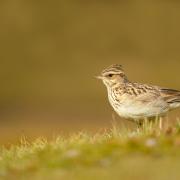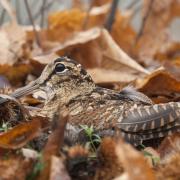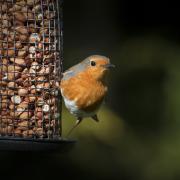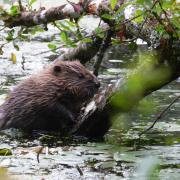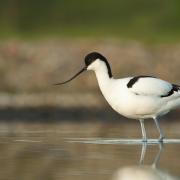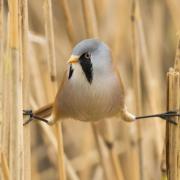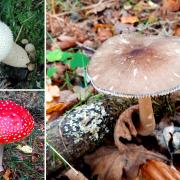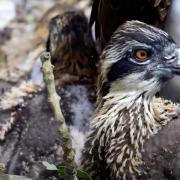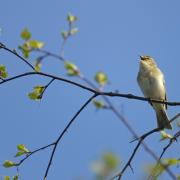Bats are often seen in the company of witches, ghosts and ghouls, this scary incarnation does little for their image.
And this negative image, says Nick Tomlinson, manager of the Dorset Wildlife Trust (DWT) reserve at Kingcombe, is largely down to one man: Bram Stoker, the author of Dracula, the Gothic horror novel published in 1897. Count Dracula, a vampire, can command bats and shape-shifts into one at will – a myth that much maligns these harmless little creatures. “Until Bram Stoker wrote Dracula, the idea of bats as vampires didn’t exist in European legends and stories,” says Nick. “In other cultures, bats are viewed very differently. For example in China they are symbols of long life, happiness, health and well-being.”
Bats, in Nick’s eyes, are ‘super creatures’, perfectly at home in the dark - in flight, they are amazingly skilful, taking a tiny midge out of the air while on the wing. They are also environmentally important, as they are a key indicator of biodiversity and habitat health. If a pollutant is introduced into a water source, for example, and kills the insects in it, the bat population is also affected as the bats rely on the insects as food. Therefore a thriving bat population indicates a thriving environment.
Keeping track of bats is not an easy task, as they are small, swift and mainly active at night. The Bat Conservation Trust, the national body that looks after British bats, runs a national monitoring programme, counting bats coming out of roosts or at hibernation sites, or using a bat detector.
“A bat detector gives us a way of peering into the bats’ world,” explains Nick. “Bats navigate using ultrasound; sound at frequencies our hearing cannot detect, which bounces off solid objects and tells them where they are.”
When you watch a bat flying it appears to be completely silent, but the bat detector reveals another story, as Nick explains. “It captures the sounds the bat emits and brings them into the range of our hearing. It is amazing to watch just one or, even better, a group of bats, using a detector. What seemed a silent, graceful ballet becomes a cacophony of noise - bats are constantly shouting! The ultrasound bounces off items, so they need to make noise the whole time to ‘see with sound’.”
An expert can identify individual species by the sounds they make. “I love it when we do a bat walk and we pick up bats on the detector – the look of surprise on people’s faces is amazing,” laughs Nick.
Kingcombe reserve is particularly rich in bats as it has been managed using no pesticides or herbicides. Bat walks at Kingcombe are open to the public; groups can book their own walk, with supper and a talk. There are also bat walks available at other DWT reserves – for details see the DWT website where you’ll also find a link to the Dorset Bat Group, which relies on volunteer help to record and protect the county’s bat population.
Radipole Lake and Sturminster Newton Mill are good places to see bats but you can also spot them in urban settings.
“We tend to think of bats as dwelling out in the countryside,” says Nick, “but they also need somewhere to roost and a roost is typically in a building. In a sheltered lane with trees, bushes and long grass that harbour lots of insects you’ll see bats – in fact anywhere where you’re dodging clouds of midges.”
Bat populations have suffered over the past century or so due to habitat changes. As an apex, predators bats are at the top of the food chain; they prey on flies, midges and moths. Increasing use of herbicides to control the plants that insects feed on and pesticides to control insect populations has led to a decline in bat numbers as their food source has disappeared.
Of the 18 British species of bats, 16 are found in Dorset, including some very rare ones. These include the Grey Long-eared Bat, of which only an estimated 1,000 remain, the Greater Horseshoe, with an estimated population of around 7,000. Dorset is also a stronghold for the very rare Bechstein’s Bat and the more common Pipistrelle and Brown Long-eared Bats.
According to Nick, Dorset is one of the best areas in the UK to be a bat worker. “When we go out and do bat box checks, on a good day we might see six or seven species. There’s no way you could see nearly half of the UK’s bird species in one day. elsewhere in the country.”
Bats are very social animals, especially the females; because bats return to the same roost year after year their roosts are protected by law. Although the females are territorial, they will share a rich source of food. “Once we were out surveying with humane traps and, much to our surprise, we didn’t catch a single bat,” recalls Nick. “There were cows in a field nearby, covered in flies, and when we switched on our head torches we’d see three or four bats in our beams – they had all piled in for the feast.”
You can spot bats hunting for insects after sunset from April to October, all UK bats hibernate from November to March. Indeed, you may have spotted bat boxes attached to trees, they are easily distinguishable from bird boxes; they have a slit in the bottom rather than a hole in the front, so the bat can land below and clamber through the slit into the box. They are usually domed at the top as bats like to cluster together to save energy. Bat boxes are available for gardens as well as woodlands, but, says Nick, bats are very choosy and will only select a box if no other roosts are available – which is one of the reasons why natural roosts are protected.
The best way to help bats, he says, is to garden for them, not using chemicals that kill food insects and planting flowers such as honeysuckle that attract night-flying insects. “If everybody did that,” he says, “it would really help our bat population.”
Bat Facts!
Bats are the only mammal capable of true flight.
Pipistrelle bats, our most numerous bat species, are about the size of your thumb and can eat up to 3,000 insects a night.
The size of bats around the world ranges from the Fruit Bat with its six foot wingspan to the tiny Hog-nosed Bat that weighs about the same as a bumble bee.
Despite making up just 1% of all UK mammals, bats are amongst the easiest to see. An evening walk along a hedgerow is likely to display a host of bats flittering and dancing.
There are about 4,500 different species of mammal in the world, around 1,000 of these are bats.
Many UK bats live for around five years although some have been known to live up to 30 years.
The Bat Conservation Trust and more than 100 local bat groups are working hard to help our bats hang on.
Discover more about bats and link up with the Dorset Bat Group at dorsetwildlife.org.uk








